Platinum lasts longer than white gold for engagement rings and wedding bands. While white gold’s initially harder surface seems protective, scratches remove metal permanently, causing your ring to thin over time. Platinum’s malleability means scratches displace rather than eliminate material, preserving structural integrity. You’ll also avoid white gold’s rhodium replating costs every 1-3 years. Platinum maintains its natural white color and develops an attractive patina while keeping gemstones more secure throughout decades of wear.
Composition and Purity Differences Between Platinum and White Gold
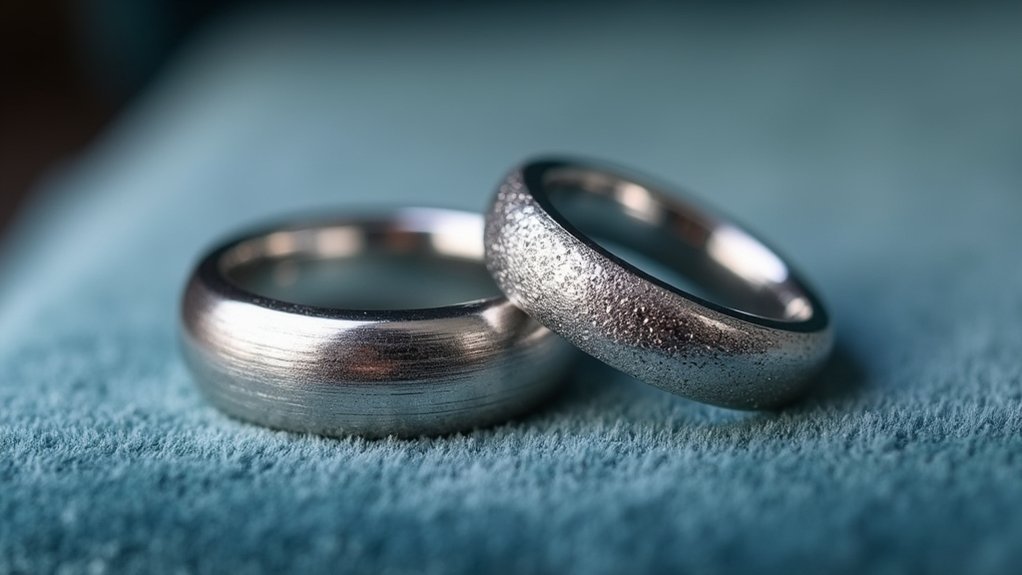
When you’re choosing between platinum and white gold, understanding their fundamental composition differences is essential for making an informed decision.
White gold’s an alloy that combines pure gold with metals like nickel, palladium, or silver, typically creating 14K (58.3% gold) or 18K (75% gold) pieces.
In contrast, platinum’s a naturally occurring metal that maintains 95% purity with minimal alloying.
This composition variance greatly impacts purity and durability.
Platinum’s higher purity makes it hypoallergenic and stronger than white gold.
While white gold requires rhodium plating for its shiny finish, platinum naturally maintains its appearance without coatings.
The density and purity of platinum contribute to superior durability, making it less prone to scratching and extending its lifespan compared to white gold’s softer alloy structure.
Scratch Resistance and Metal Hardness Comparison
Beyond composition differences, the scratch resistance and metal hardness characteristics of these metals reveal surprising contradictions that affect their long-term performance. White gold’s harder surface initially resists scratches better than platinum, but this advantage becomes a liability over time. When white gold scratches, it loses metal and gradually thins. Platinum’s superior malleability means scratches shift rather than remove metal, preserving volume and enhancing platinum durability.
| Characteristic | White Gold | Platinum |
|---|---|---|
| Initial Hardness | Higher | Lower |
| Scratch Behavior | Metal loss | Metal displacement |
| Long-term Volume | Decreases | Maintained |
| Surface Development | Rhodium wear | Patina formation |
Platinum’s density creates exceptional gemstone security, while its scratch resistance through displacement rather than removal makes it the superior choice for lasting jewelry pieces.
How Each Metal Responds to Daily Wear and Tear

Although both metals face constant exposure to bumps, scrapes, and contact with surfaces, their responses to daily wear reveal dramatically different aging patterns that directly impact your jewelry’s longevity.
Platinum’s dense composition makes it an exceptionally durable metal that displaces rather than loses material when scratched.
You’ll notice scratches develop a natural patina that many consider attractive, and your jewelry maintains its structural integrity indefinitely.
White gold initially resists scratches better due to its harder surface, but wear and tear gradually removes material, causing band thinning.
The rhodium plating finish requires replacement every 1-3 years as it wears off, revealing the underlying pale yellow metal.
Without this maintenance, your white gold jewelry loses its bright appearance and develops a dull, matte finish that requires professional restoration.
Rhodium Plating Requirements for White Gold Maintenance
You’ll need to replate your white gold jewelry with rhodium every 1-3 years as the coating wears off from daily use, revealing the underlying pale yellow gold.
This maintenance costs between $60-120 per replating, depending on your piece’s complexity and your jeweler’s rates.
Platinum doesn’t require this ongoing care since it maintains its natural white color without any protective coating.
Rhodium Coating Wears Off
When you choose white gold jewelry, you’re signing up for ongoing maintenance that platinum simply doesn’t require.
Your white gold’s rhodium plating will inevitably wear off through daily activities like handwashing, exercising, or exposure to cleaning products. You’ll notice the coating deteriorating after 1-3 years, revealing the yellowish tint underneath that makes your jewelry look dull and discolored.
This wear pattern means you’ll need professional replating every few years, costing between $60-$120 per piece.
While some jewelers offer lifetime warranties for replating services, you’re still dealing with the inconvenience of being without your jewelry during the process.
Platinum maintains its naturally white color permanently, eliminating these recurring costs and maintenance headaches entirely.
Replating Frequency and Costs
Since rhodium plating deteriorates through normal wear, you’re looking at a predictable maintenance schedule that’ll cost you both time and money.
You’ll need replating every 1 to 3 years depending on how often you wear your jewelry and what activities you expose it to.
The replating frequency translates to real costs ranging from $60 to $120 per session, with intricate designs commanding higher prices.
This rhodium plating maintenance becomes a recurring expense that adds up considerably over time. You might find yourself paying more in long-term upkeep than you initially saved by choosing white gold over platinum.
Meanwhile, platinum doesn’t require this ongoing maintenance, making it potentially more economical despite its higher upfront cost.
Maintenance Vs Platinum Care
Beyond the financial implications of repeated rhodium treatments, white gold and platinum present dramatically different maintenance philosophies.
With white gold, you’re committing to an ongoing relationship that demands regular professional attention. The rhodium coating inevitably wears away, exposing that pale yellow undertone that requires periodic revitalization to maintain your jewelry’s pristine appearance.
Platinum takes a completely opposite approach to long-term care. You won’t need any coatings, plating, or chemical treatments to preserve its natural white luster.
When platinum develops scratches, the metal simply moves rather than disappearing entirely, meaning you can restore its appearance through simple polishing without losing precious material. This fundamental difference makes platinum fundamentally maintenance-free compared to white gold’s demanding care schedule.
Platinum’s Natural Patina Development Over Time
As platinum jewelry ages, it develops a distinctive patina that sets it apart from other precious metals. Unlike white gold’s need for rhodium replating, platinum develops this natural finish through surface scratches that move rather than remove metal, preserving your jewelry’s mass. This patina finish creates unique character and depth that many people appreciate over time.
Platinum’s natural patina develops through metal movement rather than loss, creating distinctive character while preserving the jewelry’s original mass and integrity.
Here’s what makes platinum’s patina special:
- Reversible appearance – You can polish away the patina for high shine or keep it for a sophisticated matte look.
- No structural damage – The patina doesn’t compromise your jewelry’s strength or integrity.
- Cost-effective longevity – No additional coatings needed, making maintenance simpler than white gold alternatives.
This natural aging process guarantees your platinum pieces remain beautiful and durable for everyday wear.
Long-Term Structural Integrity and Metal Loss
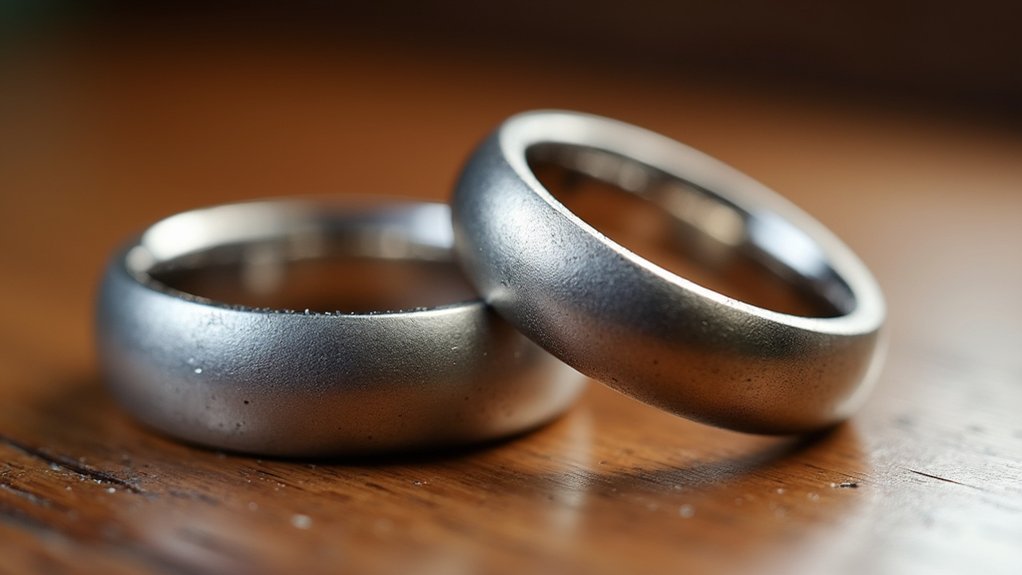
When you scratch platinum, the metal displaces rather than disappears, preserving the ring’s original mass and structural integrity over decades.
White gold’s harder surface resists initial scratching better, but you’ll lose actual metal with each mark, gradually weakening the band’s overall density.
Your platinum ring’s superior density means it can handle daily wear without the cumulative structural compromise that white gold experiences through repeated metal loss.
Metal Displacement Vs Loss
While both platinum and white gold can develop scratches through daily wear, they respond to damage in fundamentally different ways that affect their long-term durability.
When you scratch platinum, you’re experiencing metal displacement rather than metal loss. The material primarily moves from one area to another, developing a natural patina while maintaining its original mass.
White gold, however, actually loses small particles when scratched, gradually thinning over time.
This fundamental difference creates three key implications for your jewelry:
- Structural integrity – Platinum preserves its overall weight and strength indefinitely.
- Maintenance requirements – White gold needs replating every 2-5 years to restore appearance.
- Longevity – Platinum can last generations without significant material degradation, making it more sustainable for everyday wear.
Scratch Recovery Patterns
You’ll find that platinum scratches can be buffed out completely because the displaced metal remains available for redistribution across the surface.
White gold presents a different challenge – when material is actually removed through scratching, polishing can only minimize the appearance of damage rather than fully restore the original surface.
This fundamental difference means your platinum jewelry maintains better structural integrity over time, while white gold gradually becomes thinner and potentially weaker through repeated scratch-and-polish cycles.
Structural Density Impact
Beyond surface-level damage patterns, the structural density differences between platinum and white gold create profound implications for your jewelry’s longevity.
Platinum’s superior density means it won’t lose material when scratched—instead, the metal displaces and creates a protective patina. White gold, however, actually loses microscopic amounts of material with each scratch, gradually thinning your ring over time.
This density advantage translates into measurable durability benefits:
- Material retention: Platinum maintains its original mass while white gold experiences gradual material loss
- Structural integrity: Higher density prevents compromise of the ring’s framework over decades of wear
- Investment value: Platinum’s resistance to metal loss makes it a superior long-term choice
Your platinum jewelry fundamentally maintains its structural foundation indefinitely, while white gold requires more vigilant maintenance.
Stone Security and Setting Durability
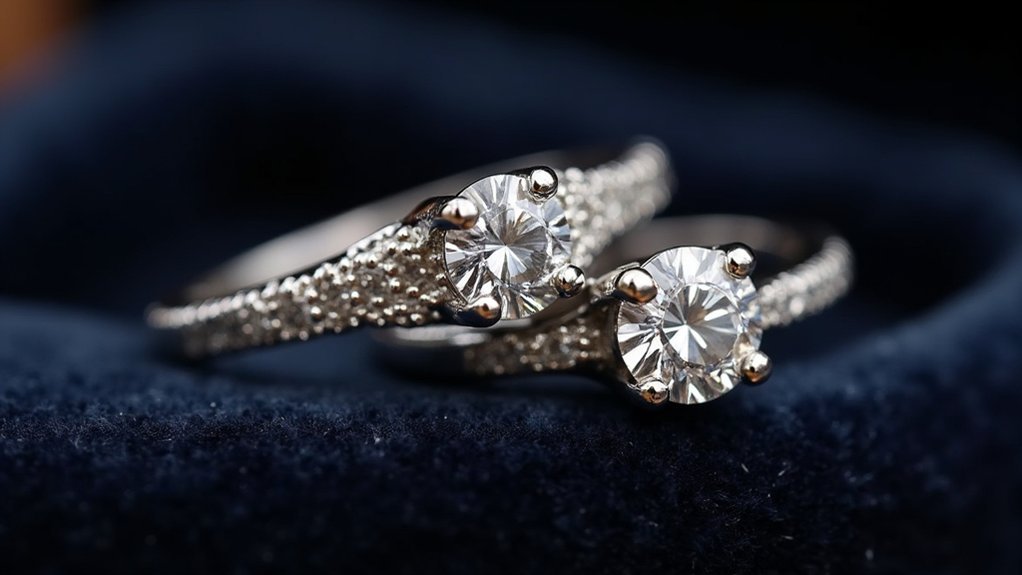
When choosing between platinum and white gold for jewelry featuring precious stones, the metal’s ability to secure gemstones becomes a critical factor in your decision.
Platinum’s superior stone security stems from its exceptional density and malleability, creating settings that grip gemstones more firmly than white gold alternatives. The setting durability of platinum outperforms white gold markedly over time.
Platinum’s exceptional density and malleability create superior gemstone settings that maintain structural integrity far longer than white gold alternatives.
While white gold may initially seem harder and more scratch-resistant, it gradually thins out as material is lost through daily wear. This thinning compromises the setting’s ability to hold stones securely.
Platinum develops a soft patina when scratched rather than losing metal, maintaining its structural integrity. This makes platinum particularly valuable for engagement rings featuring larger, more precious stones requiring unwavering security.
Maintenance Frequency and Professional Care Needs
The long-term security that platinum provides for your gemstones comes with another advantage: markedly reduced maintenance demands compared to white gold.
You’ll find yourself visiting the jeweler far less frequently with platinum pieces.
Maintenance frequency differences include:
- White gold requires rhodium replating every 2-5 years at $60-$120 per session, depending on design complexity.
- Platinum needs only periodic polishing to restore its natural shine without any coating replacement.
- Professional care intervals are longer for platinum since reconditioning doesn’t require complete surface treatments.
While both metals benefit from basic soap and warm water cleaning, white gold demands more frequent professional care as its rhodium coating wears off.
Platinum’s durability allows simple polishing rather than replating, making maintenance costs markedly lower over time.
Weight Distribution and Impact on Ring Longevity
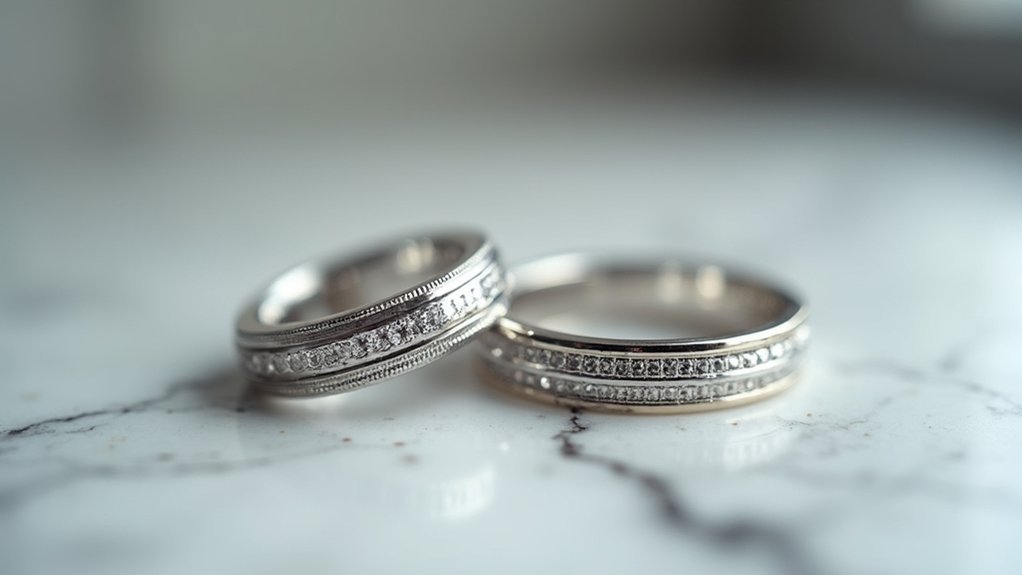
Although many buyers initially notice the substantial weight difference between platinum and white gold rings, this characteristic directly influences how long your ring will last through decades of daily wear.
Platinum’s density makes it approximately 60% heavier than white gold, creating superior durability that resists bending and breaking under stress. This extra weight isn’t just about feel—it’s fundamental to longevity.
When you scratch platinum, the metal displaces rather than disappears, maintaining the ring’s structural integrity over time. White gold, while initially harder and more scratch-resistant, gradually loses material with each scratch, leading to thinning that compromises long-term durability.
The substantial weight also helps platinum hold gemstones more securely, reducing the risk of losing precious stones compared to lighter white gold settings.
Cost of Ownership Over the Ring’s Lifetime
While platinum’s higher upfront price often deters budget-conscious buyers, you’ll discover that white gold’s seemingly attractive initial cost masks significant long-term expenses that can quickly erode your savings.
The true cost of ownership extends far beyond your initial purchase. White gold’s maintenance costs accumulate through mandatory rhodium replating every 2-5 years, costing $60-$120 per session.
Meanwhile, platinum requires only occasional polishing to maintain its lustrous appearance.
Consider these lifetime ownership factors:
- Replating expenses – White gold demands regular rhodium treatments that can exceed initial savings over time
- Durability differences – Platinum’s superior strength reduces repair needs and replacement costs
- Value retention – Platinum’s rarity (30x rarer than gold) supports long-term investment value
Platinum’s durability ultimately delivers better financial value through reduced maintenance requirements.
Frequently Asked Questions
What Lasts Longer, Platinum or White Gold?
You’ll find platinum lasts longer than white gold. While white gold’s harder, it needs replating every few years and gradually thins when scratched. Platinum doesn’t lose metal and requires less maintenance overall.
What Holds up Better, White Gold or Platinum?
You’ll find platinum holds up better than white gold. It’s denser, won’t wear away when scratched, doesn’t need replating, and develops an attractive patina while maintaining its structural integrity over decades.
Why Do Jewelers Not Like Platinum?
Jewelers often avoid platinum because you’ll find it’s harder to work with, requires specialized tools, costs more, and develops patina that needs extra polishing unlike white gold’s easy replating.
What Are the Pros and Cons of Platinum?
You’ll love platinum’s durability and hypoallergenic properties, plus it doesn’t need replating like white gold. However, you’ll pay more upfront and deal with its heavier weight, though many consider this luxurious.
In Summary
You’ll find platinum outlasts white gold in the long run. While you’re dealing with rhodium replating every few years with white gold, platinum’s naturally developing patina requires minimal maintenance. You won’t worry about metal wearing away since platinum just moves around when scratched, unlike white gold that actually loses material. Though you’ll pay more upfront, platinum’s durability means you’ll spend less on maintenance over your ring’s lifetime.




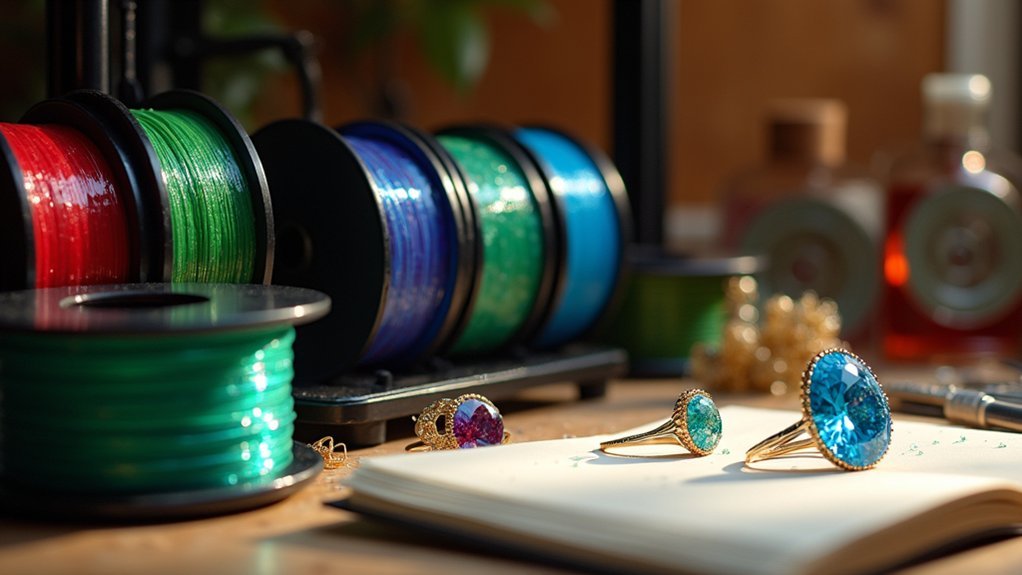
Leave a Reply